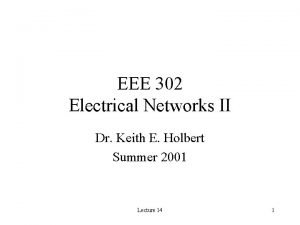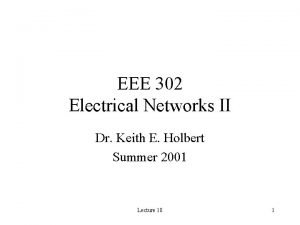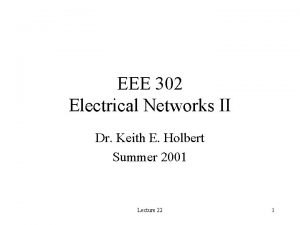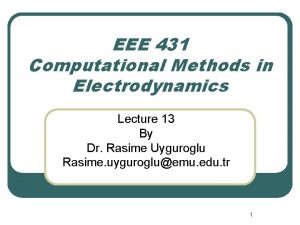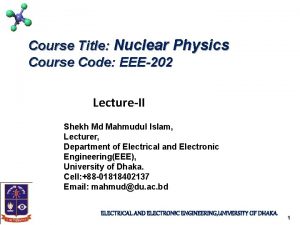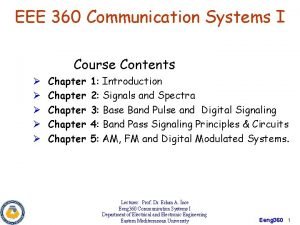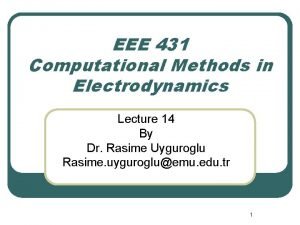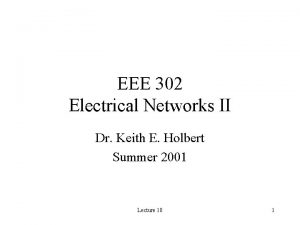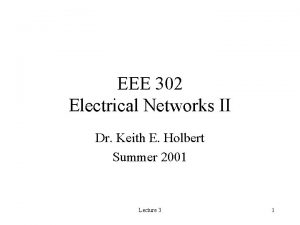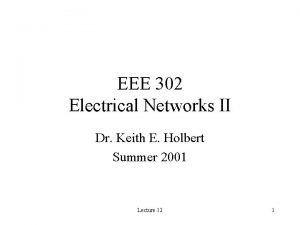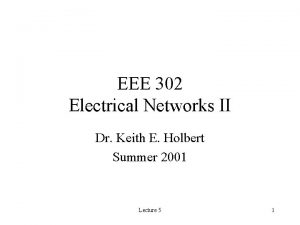EEE 302 Electrical Networks II Dr Keith E









- Slides: 9

EEE 302 Electrical Networks II Dr. Keith E. Holbert Summer 2001 Lecture 19 1

Variable-Frequency Response Analysis • As an extension of ac analysis, we now vary the frequency and observe the circuit behavior • Graphical display of frequency dependent circuit behavior can be very useful; however, quantities such as the impedance are complex valued such that we will tend to graph the magnitude of the impedance versus frequency (i. e. , |Z(j )| v. f) and the phase angle versus frequency (i. e. , Z(j ) v. f) Lecture 19 2

Frequency Response of a Resistor • Consider the frequency dependent impedance of the resistor, inductor and capacitor circuit elements • Resistor (R): ZR = R 0° Phase of ZR (°) Magnitude of ZR ( ) So the magnitude and phase angle of the resistor impedance are constant, such that plotting them versus frequency yields R Frequency 0° Frequency Lecture 19 3

Frequency Response of an Inductor • Inductor (L): ZL = L 90° Phase of ZL (°) Magnitude of ZL ( ) The phase angle of the inductor impedance is a constant 90°, but the magnitude of the inductor impedance is directly proportional to the frequency. Plotting them vs. frequency yields (note that the inductor appears as a short at dc) Frequency 90° Frequency Lecture 19 4

Frequency Response of a Capacitor • Capacitor (C): ZC = 1/( C) – 90° Phase of ZC (°) Magnitude of ZC ( ) The phase angle of the capacitor impedance is – 90°, but the magnitude of the inductor impedance is inversely proportional to the frequency. Plotting both vs. frequency yields (note that the capacitor acts as an open circuit at dc) -90° Frequency Lecture 19 5

Transfer Function • Recall that the transfer function, H(s), is • The transfer function can be shown in a block diagram as X(j ) ej t = X(s) est H(j ) = H(s) Y(j ) ej t = Y(s) est • The transfer function can be separated into magnitude and phase angle information, H(j ) = |H(j )| H(j ) Lecture 19 6

Common Transfer Functions • Since the transfer function, H(j ), is the ratio of some output variable to some input variable, • We may define any number of transfer functions – – ratio of output voltage to input current, i. e. , transimpedance, Z(jω) ratio of output current to input voltage, i. e. , transadmittance, Y(jω) ratio of output voltage to input voltage, i. e. , voltage gain, GV(jω) ratio of output current to input current, i. e. , current gain, GI(jω) Lecture 19 7

Poles and Zeros • The transfer function is a ratio of polynomials • The roots of the numerator, N(s), are called the zeros since they cause the transfer function H(s) to become zero, i. e. , H(zi)=0 • The roots of the denominator, D(s), are called the poles and they cause the transfer function H(s) to become infinity, i. e. , H(pi)= Lecture 19 8

Class Examples • Extension Exercise E 12. 1 • Extension Exercise E 12. 2 Lecture 19 9
